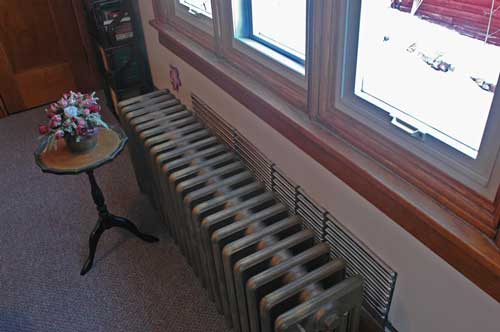 Many vintage homes in Canada are heated by classic hot water radiators, and while this system does yield a gentle, comfortable heat, it’s also responsible for a tremendous amount of hidden heat loss through the exterior walls they’re installed next to. Insulation levels in homes built before the 1980s are low enough that wall surfaces become quite cold to the touch during harsh, winter weather. This literally draws heat away from the rads before it ever gets to the room. Reducing this large and unnecessary waste is the reason why Novitherm Heat Reflectors (800-871-0079) were invented.
Many vintage homes in Canada are heated by classic hot water radiators, and while this system does yield a gentle, comfortable heat, it’s also responsible for a tremendous amount of hidden heat loss through the exterior walls they’re installed next to. Insulation levels in homes built before the 1980s are low enough that wall surfaces become quite cold to the touch during harsh, winter weather. This literally draws heat away from the rads before it ever gets to the room. Reducing this large and unnecessary waste is the reason why Novitherm Heat Reflectors (800-871-0079) were invented.
These reflectors are made of lightweight PVC with a shiny, aluminum coating on the outside face. This reflects more than 90 percent of the radiant energy back into the room and away from the wall, without actually getting hot to the touch at all. The reflectors themselves are 1 cm in depth, and can be installed in spaces as narrow a 2 cm. They nestle together compactly for shipping and are anchored to exterior walls using double-sided tape. That’s it. The reflectors last indefinitely (the oldest ones in use today were installed in the 1980s, and are still going strong), delivering energy savings of at least 10% according to results from field trials conducted on multi-residential units. Results with single family dwellings may be more or less than this. I found the reflectors easy to install, even for people with no DIY experience.
 According to independent studies by Professor Michael R. Collins at the University of Waterloo, Novitherm Canada manufactures some of the world’s most efficient reflector panels. Reflecting about 94% of heat back into the room, they typically offer a payback period of 12 to 18 months for most radiator applications in older homes. They come custom-sized for each particular rad, based on measurements you take yourself and submit with your order. If any reflectors need cutting, ordinary scissors work perfectly. When it comes to installation, the only critical issue is sealing. In order to perform effectively, the perimeter of each reflector needs to be sealed tightly against the wall. Typical cost is about $150 for the reflectors required for an entire house.
According to independent studies by Professor Michael R. Collins at the University of Waterloo, Novitherm Canada manufactures some of the world’s most efficient reflector panels. Reflecting about 94% of heat back into the room, they typically offer a payback period of 12 to 18 months for most radiator applications in older homes. They come custom-sized for each particular rad, based on measurements you take yourself and submit with your order. If any reflectors need cutting, ordinary scissors work perfectly. When it comes to installation, the only critical issue is sealing. In order to perform effectively, the perimeter of each reflector needs to be sealed tightly against the wall. Typical cost is about $150 for the reflectors required for an entire house.
There’s no trick to building brand new homes that use less than 25 percent of the energy required by older structures. Today’s best building technologies make this goal easily achievable with changes to just a few fundamental design details. What’s more difficult is raising the energy performance of Canada’s large stock of existing houses. This requires many different, smaller technical fixes, including heat reflectors behind rads and diligent people willing to take the time to put them in place. Isn’t it time we got serious?
- View Steve Maxwell’s how-to install video for Novitherm Heat Reflectors.


